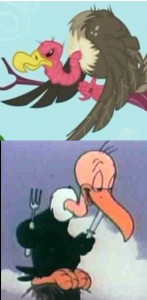Buzzards
 During my free time this weekend I was playing with a bit of fan art involving a comical Game of Thrones/MLP: Friendship is Magic crossover. (Yes I know please don’t judge me) which involved the “buzzard” that has appeared in the background in several cartoons. This got me to thinking the representation of vultures in cartoons.
During my free time this weekend I was playing with a bit of fan art involving a comical Game of Thrones/MLP: Friendship is Magic crossover. (Yes I know please don’t judge me) which involved the “buzzard” that has appeared in the background in several cartoons. This got me to thinking the representation of vultures in cartoons.
Vultures are usually convenient shorthand for looming disaster and death and this symbolism and humor in American cartoons has continued in figures like Beaky Buzzard in early Warner Brothers cartoons to Sarcophagus MacAbre in Pogo and onward (the one from MLP: Friendship is Magic is a bit of a subversion as while it looks extremely sinister it is clearly one of Fluttershy’s animal friends.) But one thing that always interests me is despite most of these vultures are generally cartoon versions of an old world vulture as opposed to a “buzzard” (a nickname for new world vultures, specifically the Turkey Vulture) for example that ruff most of them probably comes from a Griffon Vulture (though to be fair some Condors have them too. ) The MLP “buzzard” looks a lot more like a Turkey Vulture then most of it’s cartoon predecessors but again they kept the ruff.
The other thing I was thinking about was the use of the word buzzard as a word for an American Vulture. The original meaning (and the meaning that is still in use in Europe) is a Hawk of the genus Buteo or more generally a hawk with with broad wings and a broad tail. Because of this I find myself wondering how “Buzzard”, meaning Vulture, caught on when settlers and taxonomists in the new world would be fully aware of “real buzzards”, like the Red-Tail Hawk, flying around.
Update: After throwing this question around for most of the morning I was pointed towards the Vulture Society Page. Which speculated that since there are no vultures in the British isles (and thus no English word for vulture) the word Buzzard was used by settlers as a catch all term for any large soaring bird.







You must be logged in to post a comment.